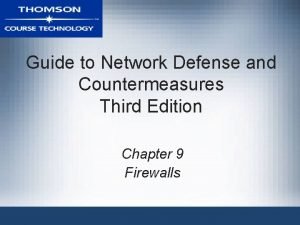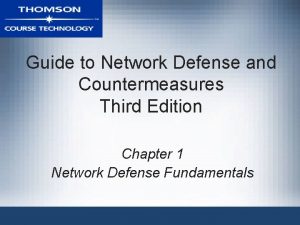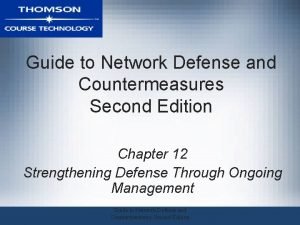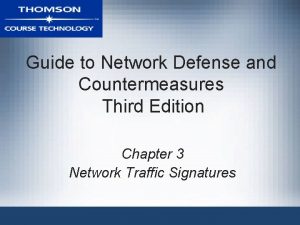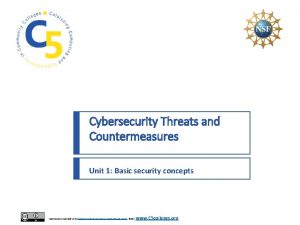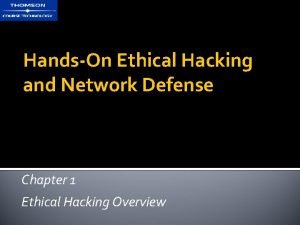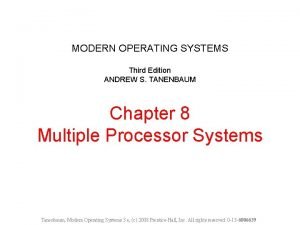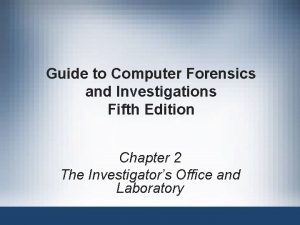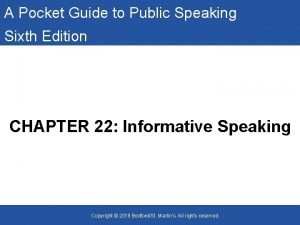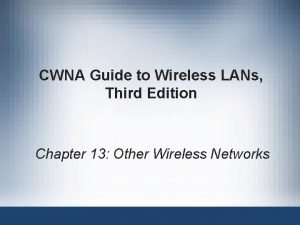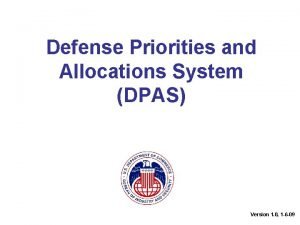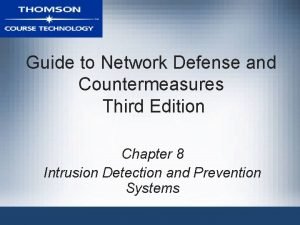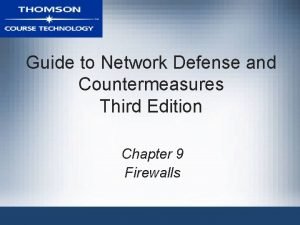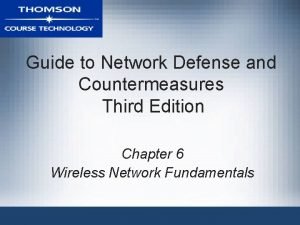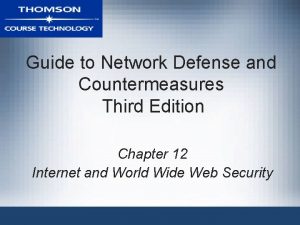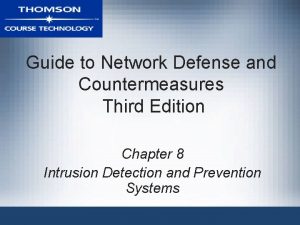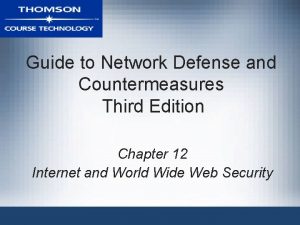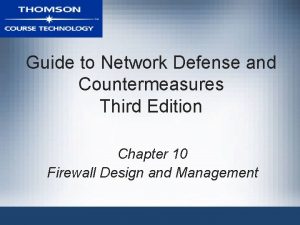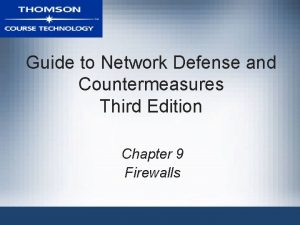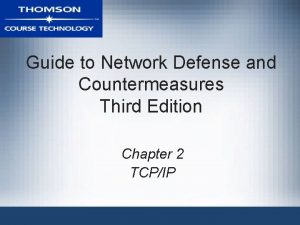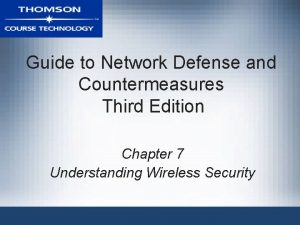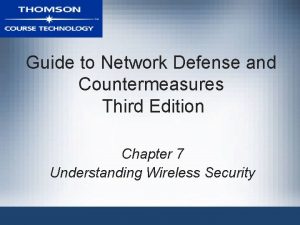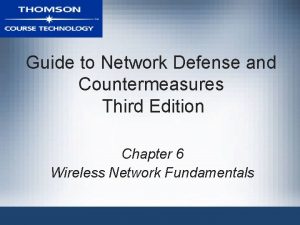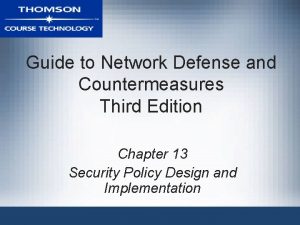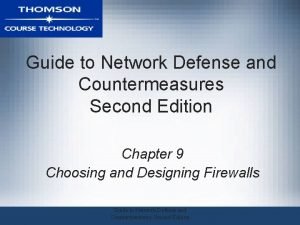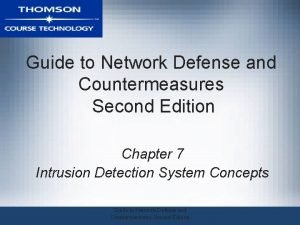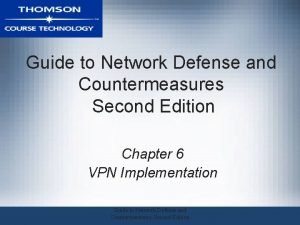Guide to Network Defense and Countermeasures Third Edition









































































- Slides: 73

Guide to Network Defense and Countermeasures Third Edition Chapter 11 Virtual Private Network (VPN) Concepts

Objectives • • • Explain basic VPN concepts Describe encapsulation in VPNs Describe encryption in VPNs Describe authentication in VPNs Summarize the advantages and disadvantages of VPNs Guide to Network Defense and Countermeasures, Second Edition 2

Objectives (contd. ) • • • Explain design considerations for a VPN Describe options for VPN configuration Explain how to set up VPNs with firewalls Explain how to adjust packet-filtering rules for VPNs Describe guidelines for auditing VPNs and VPN policies Guide to Network Defense and Countermeasures, Second Edition 3

Understanding VPN Concepts • Virtual Private Network (VPN) enables computers to – Communicate securely over insecure channels – Exchange private encrypted messages that others cannot decipher Guide to Network Defense and Countermeasures, Second Edition 4

What VPNs Are • VPN – Virtual network connection – Uses the Internet to establish a secure connection • Secure tunnel – Extends an organization’s network • Endpoints – Specified computers, users, or network gateways Guide to Network Defense and Countermeasures, Second Edition 5

Guide to Network Defense and Countermeasures, Second Edition 6

Why Establish a VPN? • Business incentives driving VPN adoption – VPNs are cost-effective – VPNs provide secure connection for remote users • Contractors • Traveling employees • Partners and suppliers • VPN Components – VPN server or host • Configured to accept connections from clients – VPN client or guest • Endpoints connecting to a VPN Guide to Network Defense and Countermeasures, Second Edition 7

Why Establish a VPN? (continued) • VPN Components – Tunnel • Connection through which data is sent – VPN protocols • Sets of standardized communication settings • Used to encrypt data sent along the VPN – Types of VPNs • Site-to-site VPN – Gateway-to-gateway VPN • Client-to-site VPN – Remote access VPN Guide to Network Defense and Countermeasures, Second Edition 8

Why Establish a VPN? (continued) • Hardware versus software VPNs – Hardware-based VPNs • Connect one gateway to another • Routers at each network gateway encrypt and decrypt packets • VPN appliance – Designed to serve as VPN endpoint – Join multiple LANs • Benefits – Scalable – Better security Guide to Network Defense and Countermeasures, Second Edition 9

Guide to Network Defense and Countermeasures, Second Edition 10

Guide to Network Defense and Countermeasures, Second Edition 11

Why Establish a VPN? (continued) • Hardware versus software VPNs (continued) – Software-based VPNs • Integrated with firewalls • Appropriate when participating networks use different routers and firewalls • Benefits – More cost-effective – Offer maximum flexibility Guide to Network Defense and Countermeasures, Second Edition 12

Guide to Network Defense and Countermeasures, Second Edition 13

Why Establish a VPN? (continued) • VPN combinations – Combining VPN hardware with software adds layers of network security – One useful combination is a VPN bundled with a firewall – VPNs do not eliminate the need for firewalls – Provide flexibility and versatility Guide to Network Defense and Countermeasures, Second Edition 14

Why Establish a VPN? (continued) • VPN combinations (continued) – Points to consider when selecting VPNs • • • Compatibility Scalability Security Cost Vendor support Guide to Network Defense and Countermeasures, Second Edition 15

VPN Core Activity 1: Encapsulation • Core set of activities – Encapsulation – Encryption – Authentication • Encapsulation – Encloses a packet within another • That has different IP source and destination – Protects integrity of the data Guide to Network Defense and Countermeasures, Second Edition 16

Guide to Network Defense and Countermeasures, Second Edition 17

Understanding Tunneling Protocols • Point-to-Point Tunneling Protocol (PPTP) – Used when you need to dial in to a server with a modem connection • On a computer using an older OS version – Encapsulates TCP/IP packets – Header contains only information needed to route data from the VPN client to the server – Uses Microsoft Point-to-Point Encryption (MPPE) • Encrypt data that passes between the remote computer and the remote access server – L 2 TP uses IPSec encryption • More secure and widely supported Guide to Network Defense and Countermeasures, Second Edition 18

Understanding Tunneling Protocols (continued) • Layer 2 Tunneling Protocol (L 2 TP) – Provides better security through IPSec – IPSec enables L 2 TP to perform • Authentication • Encapsulation • Encryption Guide to Network Defense and Countermeasures, Second Edition 19

Guide to Network Defense and Countermeasures, Second Edition 20

Understanding Tunneling Protocols (continued) • Secure Shell (SSH) – Provides authentication and encryption – Works with UNIX-based systems • Versions for Windows are also available – Uses public-key cryptography • Socks V. 5 – Provides proxy services for applications • That do not usually support proxying – Socks version 5 adds encrypted authentication and support for UDP Guide to Network Defense and Countermeasures, Second Edition 21

IPSec/IKE • Internet Protocol Security (IPSec) – Set of standard procedures – Developed by the Internet Engineering Task Force (IETF) – Enables secure communications on the Internet • Characteristics – – Works at layer 3 Can encrypt an entire TCP/IP packet Originally developed for use with IPv 6 Provides authentication of source and destination computers Guide to Network Defense and Countermeasures, Second Edition 22

IPSec/IKE (continued) • Widely supported • Security Association (SA) – Relationship between two or more entities – Describes how they will use security services to communicate – Used by IPSec to track all the particulars of a communication session – SAs are unidirectional Guide to Network Defense and Countermeasures, Second Edition 23

IPSec/IKE (continued) • Components – Internet Security Association Key Management Protocol (ISAKMP) – Internet Key Exchange (IKE) – Oakley – IPSecurity Policy Management – IPSec Driver • IPSec core components – Authentication Header (AH) – Encapsulation Security Payload (ESP) Guide to Network Defense and Countermeasures, Second Edition 24

IPSec/IKE (continued) • Authentication Header (AH) – – Provides authentication of TCP/IP packets Ensures data integrity Packets are signed with a digital signature Adds a header calculated by the values in the datagram • Creating a messages digest of the datagram – AH in tunnel mode • Authenticates the entire original header • Places a new header at the front of the original packet – AH in transport mode • Authenticates the payload and the header Guide to Network Defense and Countermeasures, Second Edition 25

Guide to Network Defense and Countermeasures, Second Edition 26

Guide to Network Defense and Countermeasures, Second Edition 27

IPSec/IKE (continued) • Encapsulation Security Payload (ESP) – Provides confidentiality for messages – Encrypts different parts of a TCP/IP packet – ESP in tunnel mode • Encrypts both the header and data part of each packet • Data cannot pass through a firewall using NAT – ESP in transport mode • Encrypts only data portion of the packet • Data can pass through a firewall – IPSec should be configured to work with transport mode Guide to Network Defense and Countermeasures, Second Edition 28

Guide to Network Defense and Countermeasures, Second Edition 29

VPN Core Activity 2: Encryption • Encryption – Process of rendering information unreadable by all but the intended recipient – Components • Key • Digital certificate • Certification Authority (CA) – Key exchange methods • • Symmetric cryptography Asymmetric cryptography Internet Key Exchange FWZ Guide to Network Defense and Countermeasures, Second Edition 30

Guide to Network Defense and Countermeasures, Second Edition 31

Encryption Schemes Used by VPNs • Triple Data Encryption Standard (3 DES) – Used by many VPN hardware and software – 3 DES is a variation on Data Encryption Standard (DES) – DES is not secure – 3 DES is more secure • Three separate 64 -bit keys to process data – 3 DES requires more computer resources than DES Guide to Network Defense and Countermeasures, Second Edition 32

Guide to Network Defense and Countermeasures, Second Edition 33

Encryption Schemes Used by VPNs (continued) • Secure Sockets Layer (SSL) – Developed by Netscape Communications Corporation – Enables Web servers and browsers to exchange encrypted information – Characteristics • Uses public and private key encryption • Uses sockets method of communication • Operates at network layer (layer 3) of the OSI model – Widely used on the Web • Only supports data exchanged by Web-enabled applications • Unlikely to replace IPSec Guide to Network Defense and Countermeasures, Second Edition 34

Encryption Schemes Used by VPNs (continued) • Secure Sockets Layer (SSL) (continued) – Steps • Client connects to Web server using SSL protocol • Two machines arrange a “handshake” process – Client sends its preferences for encryption method, SSL version number, and a randomly generated number • Server responds with SSL version number, its own cipher preferences, and its digital certificate • Client verifies date and other information on the digital certificate – Client generates and send a “pre-master” code Guide to Network Defense and Countermeasures, Second Edition 35

Encryption Schemes Used by VPNs (continued) • Secure Sockets Layer (SSL) (continued) – Steps • Server uses its private key to decode pre-master code – Generates a master secret key – Client and server use it to generate session keys • Server and client exchange messages saying handshake is completed • SSL session begins Guide to Network Defense and Countermeasures, Second Edition 36

VPN Core Activity 3: Authentication • Authentication – Identifying a user or computer as authorized to access and use network resources – Types of authentication methods used in VPNs • IPSec • MS-CHAP – Both computers exchange authentication packets and authenticate one another – VPNs use digital certificates to authenticate users Guide to Network Defense and Countermeasures, Second Edition 37

Guide to Network Defense and Countermeasures, Second Edition 38

Advantages and Disadvantages of VPNs Guide to Network Defense and Countermeasures, Second Edition 39

Designing a VPN • Assess organization’s needs and goals – – Type of business How many employees it has Infrastructure already in place Security required • Enforce security on the client side of the VPN tunnel – Most difficult aspect of the design process Guide to Network Defense and Countermeasures, Second Edition 40

Business Needs • Business processes – Determine how you will implement a VPN strategy • Careful analysis of the existing infrastructure – Helps you integrate the VPN with minimal disruption • VPNs can be classified as site-to-site or client-to-site – Can offer cost-effective, secure connectivity • Legal implications to failing to secure access to a remote network Guide to Network Defense and Countermeasures, Second Edition 41

Business Needs (continued) • Nature of the business – – What does it do? What product or service does it sell? Who are its customers? Cost is usually a key factor • Narrows the choices of hardware and software Guide to Network Defense and Countermeasures, Second Edition 42

Business Needs (continued) • Nature of the business – A secure VPN design should address: • • Secure connectivity Availability Authentication Secure management Reliability Scalability Performance Guide to Network Defense and Countermeasures, Second Edition 43

Client Security • Several ways to increase VPN client security • Split tunneling – Describes multiple paths – One path goes to the VPN server and is secured – Another unauthorized and unsecured path permits users to connect to the Internet • While still connected to the corporate VPN – Leaves the VPN server and internal LAN vulnerable to attack Guide to Network Defense and Countermeasures, Second Edition 44

Guide to Network Defense and Countermeasures, Second Edition 45

Guide to Network Defense and Countermeasures, Second Edition 46

Client Security (continued) • Planning VPN deployment – Consider the existing infrastructure • Make a network map – Decide on the placement of VPN servers – Research hardware and software to use • Decide whether you need new hardware or software • Sometimes you can reconfigure existing resources to support a VPN – Develop a list of requirements • When you meet a vendor so nothing is overlooked – Follow security policy guidelines Guide to Network Defense and Countermeasures, Second Edition 47

VPN Topology Configurations • VPN topology – How components in a network are connected physically to one another – Determines how gateways, networks, and clients are related to each other – Corresponds to the basic physical and logical topologies of any network Guide to Network Defense and Countermeasures, Second Edition 48

VPN Topology Configurations (continued) • Mesh topology – All participants in the VPN have Security Associations (SAs) with one another – Types of mesh arrangements • Full mesh – Every subnetwork is connected to all other subnets in the VPN – Complex to manage • Partial mesh – Any subnet in the VPN may or may not be connected to the other subnets Guide to Network Defense and Countermeasures, Second Edition 49

Guide to Network Defense and Countermeasures, Second Edition 50

VPN Topology Configurations (continued) • Star topology – Also known as a hub-and-spoke configuration – VPN gateway is the hub – Networks that participate in the VPN are called rim subnetworks – Separate SAs are made between the hubs of each rim subnetwork in the star configuration – Central VPN router is at organization’s central office – Any LANs or computers that want to participate need to connect only to the central server Guide to Network Defense and Countermeasures, Second Edition 51

Guide to Network Defense and Countermeasures, Second Edition 52

VPN Topology Configurations (continued) • Hybrid topology – Combines two different network topologies – Central core uses a mesh topology • Mesh topologies tend to operate more efficiently – Branch offices can be connected using a star topology – Benefits from strengths of each topology • Scalability (of the star topology) • Speed (of the mesh configuration) Guide to Network Defense and Countermeasures, Second Edition 53

Guide to Network Defense and Countermeasures, Second Edition 54

Using VPNs with Firewalls • VPNs do not reduce the need for a firewall – Always use a firewall as part of VPN security design • Install VPN software on the firewall itself – Firewall allows outbound access to the Internet – Firewall prevents inbound access from the Internet – VPN service encrypts traffic to remote clients or networks Guide to Network Defense and Countermeasures, Second Edition 55

Using VPNs with Firewalls (continued) • Install VPN software on the firewall itself – Advantages • Control all network access security from one server • Fewer computers to manage • Use the same tools for VPN and firewall – Disadvantages • Single point of failure • Must configure routes carefully • Internet access and VPN traffic compete for resources on the server Guide to Network Defense and Countermeasures, Second Edition 56

Guide to Network Defense and Countermeasures, Second Edition 57

Using VPNs with Firewalls (continued) • Set up VPN parallel to your firewall inside the DMZ – Advantages • No need to modify firewall settings to support VPN traffic • Configuration scales more easily • Can deal with congested servers – Disadvantages • VPN server is connected directly to the Internet • If VPN server becomes compromised, attacker will have direct access to your internal network • Cost of supporting a VPN increases with new servers Guide to Network Defense and Countermeasures, Second Edition 58

Guide to Network Defense and Countermeasures, Second Edition 59

Using VPNs with Firewalls (continued) • Set up VPN server behind the firewall connected to the internal network – Advantages • VPN server is completely protected from the Internet • Firewall is the only device controlling access • VPN traffic restrictions are configured on VPN server – Disadvantages • VPN traffic must travel through the firewall • Firewall must handle VPN traffic • Firewall might not know what to do with IP protocols other than ICMP, TCP, and UDP Guide to Network Defense and Countermeasures, Second Edition 60

Guide to Network Defense and Countermeasures, Second Edition 61

Adjusting Packet-Filtering Rules for VPNs • Perimeter firewall filters packets VPN sends or receives • Packet filtering is based on header fields of inbound and outbound packets • IP packet header fields used by packet filtering – Source address – Destination address – Protocol identifier • You can conduct packet filtering based on any or all of these header fields Guide to Network Defense and Countermeasures, Second Edition 62

PPTP Filters • PPTP – – First widely supported VPN protocol Supports legacy authentication methods Does not require PKI Might be only option when VPN connections pass through NAT – PPTP uses two protocols • TCP • GRE Guide to Network Defense and Countermeasures, Second Edition 63

Guide to Network Defense and Countermeasures, Second Edition 64

L 2 TP and IPSec Filters • Need to set up rules that permit IPSec traffic – IKE uses protocol ID 171 and UDP on port 500 – ESP uses protocol ID 50 – AH uses protocol ID 51 Guide to Network Defense and Countermeasures, Second Edition 65

Guide to Network Defense and Countermeasures, Second Edition 66

Auditing VPNs and VPN Policies • Auditing needed to make sure organizations have a well-define VPN policy • Access policies define standards for connecting to the organization’s network – Must be integrated with the security policy • Policies should be defined for different levels of restrictions • VPN endpoints are as vulnerable as internal network computers – Endpoints should also use antivirus software and personal firewalls Guide to Network Defense and Countermeasures, Second Edition 67

Auditing VPNs and VPN Policies (continued) • Test each client that will connect to your LAN – Helps prevent network threats • You can standardize VPN client for remote users • Third-party solutions – Cisco Secure VPN Client – Nokia VPN Client – Sonic. WALL VPN Client • Verify everything is working according to your policies Guide to Network Defense and Countermeasures, Second Edition 68

Summary • Business nature helps determine your VPN requirements • Decide placement of VPN servers – Research hardware and software to use • Establish a VPN domain • VPN configurations – Single entry point configurations – Multiple entry point configurations • VPNs need to be used with firewalls Guide to Network Defense and Countermeasures, Second Edition 69

Summary (continued) • Adjust packet-filtering rules – To allow PPTP, L 2 TP, and IPSec traffic • Auditing VPNs and VPN policies – After you have installed and configured your VPN • Work with a knowledgeable remote user – Helps determine a baseline for future auditing, testing, and troubleshooting Guide to Network Defense and Countermeasures, Second Edition 70

Summary • VPNs do not make use of dedicated leased lines • VPNs send data through a secure tunnel that leads from one endpoint to another • VPNs keep critical business communications private and secure • VPN components – VPN servers – VPN clients – Protocols Guide to Network Defense and Countermeasures, Second Edition 71

Summary (continued) • VPN types – Site-to-site – Client-to-site • Encapsulation encloses one packet within another – Conceals the original information • VPN protocols – – Secure Shell (SSH) Socks version 5 Point-to-Point Tunneling Protocol (PPTP) Layer 2 Tunneling Protocol (L 2 TP) Guide to Network Defense and Countermeasures, Second Edition 72

Summary (continued) • IPSec/IKE • Encryption makes the contents of the packet unreadable • Authentication ensures participating computers are authorized users – Kerberos: strong authentication system • VPN advantages – High level of security at low cost • VPN disadvantages – Can introduce serious security risks Guide to Network Defense and Countermeasures, Second Edition 73
 Guide to network defense and countermeasures
Guide to network defense and countermeasures Guide to network defense and countermeasures
Guide to network defense and countermeasures Guide to network defense and countermeasures
Guide to network defense and countermeasures Guide to network defense and countermeasures
Guide to network defense and countermeasures Cyber security threats and countermeasures
Cyber security threats and countermeasures Cache attacks and countermeasures: the case of aes
Cache attacks and countermeasures: the case of aes Csrf countermeasures
Csrf countermeasures Spill prevention control & countermeasures training
Spill prevention control & countermeasures training What are the first line of defense
What are the first line of defense What is the third line of defense in the immune system
What is the third line of defense in the immune system Third line of defense immune system
Third line of defense immune system 1st 2nd and 3rd line of defense immune system
1st 2nd and 3rd line of defense immune system What are the immune systems 3 lines of defense
What are the immune systems 3 lines of defense Gingival third vs cervical third
Gingival third vs cervical third Mount and hume classification
Mount and hume classification Ethical hacking and network defense
Ethical hacking and network defense Principle of economics third edition
Principle of economics third edition Organic chemistry david klein 3rd edition
Organic chemistry david klein 3rd edition Organic chemistry third edition david klein
Organic chemistry third edition david klein Business mathematics third edition
Business mathematics third edition Modern operating systems tanenbaum
Modern operating systems tanenbaum Fundamentals of corporate finance canadian edition
Fundamentals of corporate finance canadian edition Sujata madan
Sujata madan Lifespan development third edition
Lifespan development third edition Lifespan development third edition
Lifespan development third edition Cell biology third edition
Cell biology third edition Joey's first 14 quiz grades in a marking period were
Joey's first 14 quiz grades in a marking period were Marking bad clusters data hiding technique
Marking bad clusters data hiding technique Guide to computer forensics and investigations 5th edition
Guide to computer forensics and investigations 5th edition Mis chapter 6
Mis chapter 6 Using mis (10th edition)
Using mis (10th edition) Cryptography and network security 6th edition
Cryptography and network security 6th edition Cryptography and network security 6th edition pdf
Cryptography and network security 6th edition pdf Cryptography and network security 4th edition
Cryptography and network security 4th edition Pearson cryptography and network security
Pearson cryptography and network security Florida real estate broker's guide 6th edition
Florida real estate broker's guide 6th edition Florida real estate broker's guide
Florida real estate broker's guide A pocket guide to public speaking 6th edition
A pocket guide to public speaking 6th edition Guide to wireless communications
Guide to wireless communications Prehospital emergency care 11th edition
Prehospital emergency care 11th edition Florida real estate broker's guide 6th edition
Florida real estate broker's guide 6th edition Florida real estate broker's guide 6th edition
Florida real estate broker's guide 6th edition Cwna guide to wireless lans 3rd edition
Cwna guide to wireless lans 3rd edition Florida real estate broker's guide
Florida real estate broker's guide A pocket guide to public speaking 6th edition
A pocket guide to public speaking 6th edition A pocket guide to public speaking 6th edition
A pocket guide to public speaking 6th edition Dk guide to public speaking 2nd edition
Dk guide to public speaking 2nd edition Florida real estate broker's guide 6th edition
Florida real estate broker's guide 6th edition Florida real estate broker's guide
Florida real estate broker's guide Florida real estate broker's guide 6th edition
Florida real estate broker's guide 6th edition Network security essentials 5th edition pdf
Network security essentials 5th edition pdf Dragon network edition
Dragon network edition Network security essentials 5th edition
Network security essentials 5th edition Virtual circuit tables
Virtual circuit tables Features of peer to peer network and client server network
Features of peer to peer network and client server network Network centric computing and network centric content
Network centric computing and network centric content Guide to network security
Guide to network security Information rules a strategic guide to the network economy
Information rules a strategic guide to the network economy Security guide to network security fundamentals
Security guide to network security fundamentals Security guide to network security fundamentals
Security guide to network security fundamentals Types of network topology
Types of network topology Network systems design using network processors
Network systems design using network processors Packet switching disadvantages
Packet switching disadvantages Newton's first law and second law and third law
Newton's first law and second law and third law Si unit of newton's first law
Si unit of newton's first law First person or third person
First person or third person Who is the main character in monkey's paw
Who is the main character in monkey's paw Usw strike and defense fund
Usw strike and defense fund Executive order 12919
Executive order 12919 Defense office of hearings and appeals
Defense office of hearings and appeals Configuration management for aerospace and defense
Configuration management for aerospace and defense Lesson outline transport and defense answer key
Lesson outline transport and defense answer key In defense of romeo and juliet
In defense of romeo and juliet Verbal defense and influence
Verbal defense and influence
